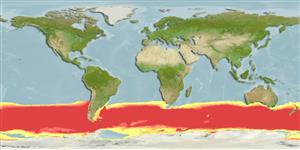>
Scombriformes (Mackerels) >
Gempylidae (Snake mackerels)
Etymology: Paradiplospinus: Greek, para = the side of + Greek, diploos = double + Latin, spina, pinna = thron (Ref. 45335).
More on author: Andriashev.
Issue
Validity of species questionnable for some authors, but no recent publications.
Environment: milieu / climate zone / depth range / distribution range
ນິເວດວິທະຍາ
ສັດທະເລ ກ່ຽວກັບ (ຢູ່) ຊັ້ນນ້ຳໃນທະເລເປີດທີ່ປອດແສງສ່ອງເຖິງ; ລະດັບຄວາມເລິກ 0 - 2830 m (Ref. 6181). Deep-water; 31°S - 79°S, 180°W - 180°E (Ref. 6181)
Southern Ocean: circumpolar. In the belief that there was only a single species of Paradiplospinus, many authors used the name Paradiplospinus gracilis as including Paradiplospinus antarcticus.
ຂະໜາດ / ນ້ຳໜັກ / Age
Maturity: Lm ? range ? - ? cm
Max length : 52.0 cm SL ຕົວຜູ້/ບໍ່ມີເພດ; (Ref. 6181); common length : 35.0 cm SL ຕົວຜູ້/ບໍ່ມີເພດ; (Ref. 6181)
ຄີ (ໜາມ)ແຂງຢູ່ຫຼັງປາ (ທັງໝົດ) : 36 - 39; ຄີຫຼັງຂອງປາ (ຄີອ່ອນ) (ທັງໝົດ) : 24 - 34; ຄີ(ໜາມ) ແຂງຢູ່ຄີກົ້ນປາ
ກຸ່ມປາກະດູກແຂງ
ຄວາມຖີ່ຂອງກຸ່ມຖ່າຍທອດພັນ
ປາທີ່ມີການເຄື່ອນຍ້າຍຈາກທະເລໄປຫານ້ຳຈືດ ແລະນ້ຳຈືດຫາທະເລ
ປາທີ່ມີການເຄື່ອນຍ້າຍຈາກທະເລແລະໄປໄຂ່ຢູ່ນ້ຳຈືດ
ຄີກົ້ນຂອງປາ
ສັດທີ່ມີກະດູກສັນຫັຼງ
ການຖ່າຍທອດທາງກຳມະພັນຈາກພໍ່ແມ່ຫາລູກ: 2; ຄີກົ້ນຂອງປາ: 25 - 31; ສັດທີ່ມີກະດູກສັນຫຼັງ: 64 - 67. Body is extremely elongate. Mouth with fang-like teeth, 3-6 fangs anteriorly in upper jaw and 1 fang on each side of the lower jaw. Pyloric caeca 6. Color is silvery white without any conspicuous marks except 40 - 50 narrow longitudinal lines of pale melanophores; the dorsal-fin base, opercular region and caudal-fin origin dark brownish.
Adults and subadults epipelagic to mesopelagic, or mesobenthopelagic at shelves and slopes from surface to 830 m (temp. 0° to 4°C). Larvae and juveniles, probably mesopelagic to bathypelagic, down to 2,830 m depth (Ref. 5084). Feeds on krill, squid and fishes (predominantly myctophids). Larval and juvenile specimens mostly obtained between southern land masses and the Antarctic continent.
Life cycle and mating behavior
Maturities | ການສືບພັນ | Spawnings | Egg(s) | Fecundities | ຕົວອ່ອນ
Nakamura, I. and N.V. Parin, 1993. FAO Species Catalogue. Vol. 15. Snake mackerels and cutlassfishes of the world (families Gempylidae and Trichiuridae). An annotated and illustrated catalogue of the snake mackerels, snoeks, escolars, gemfishes, sackfishes, domine, oilfish, cutlassfishes,. scabbardfishes, hairtails, and frostfishes known to date. FAO Fish. Synop. 125(15):136 p. (Ref. 6181)
IUCN Red List Status (Ref. 130435)
Threat to humans
Harmless
Human uses
ການປະມົງ: ທີ່ບໍ່ມີຄວາມສົນໃຈ
ເຄື່ອງມື
Special reports
Download XML
ແຫຼ່ງອີນເຕີເນັດ
Estimates based on models
Preferred temperature (Ref.
123201): 0.8 - 7.8, mean 3.5 °C (based on 694 cells).
Phylogenetic diversity index (Ref.
82804): PD
50 = 0.7500 [Uniqueness, from 0.5 = low to 2.0 = high].
Bayesian length-weight: a=0.00363 (0.00163 - 0.00807), b=3.10 (2.91 - 3.29), in cm total length, based on LWR estimates for this (Sub)family-body shape (Ref.
93245).
ຊັ້ນເຂດຮ້ອນ (Ref.
69278): 4.1 ±0.53 se; based on food items.
ຄວາມຢືດຢຸ່ນ (Ref.
120179): ຂະໜາດກາງ, ປະຊາກອນຕຳ່ສຸດທີ່ໃຊ້ເວລາສອງເທົ່າ 1.4 - 4.4 ປີ (Preliminary K or Fecundity.).
Fishing Vulnerability (Ref.
59153): Moderate to high vulnerability (45 of 100).
